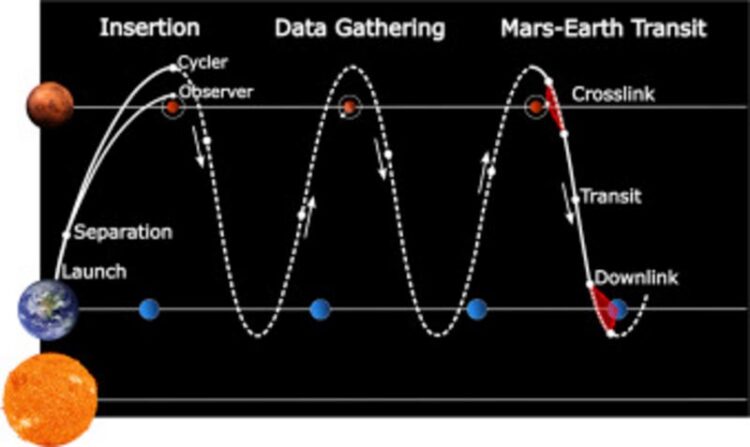Data transport using train of satellites

Concept of operations for one cycler spacecraft
Credit: The Grainger College of Engineering at University of Illinois Urbana-Champaign
Although the Pony Express lasted only a short time in the mid-1800s before being outperformed by the transcontinental telegraph, it inspired a concept for a string of small satellites to transport data from Mars to Earth and help alleviate the data logjam currently occurring in the Deep Space Network.
“The Solar System Pony Express is a mission concept that aims to augment the data transmission capabilities of the Deep Space Network using the idea of data mules,” said Robyn Woollands, assistant professor in the Department of Aerospace Engineering at the University of Illinois Urbana-Champaign.
Woollands described the data mules as small spacecraft that can travel to a remote location, such as Mars, where they acquire data in close range to the probe’s transmitter, then carry the data back to Earth where it is downlinked in close range to the receiver. This enables high latency and high bandwidth communication.
“A network of interplanetary data mules could be established using cycler orbits,” Woollands said. “After launch, the data mules use their own low-thrust propulsion system to inject into a cycler orbit and target subsequent flybys of Earth and Mars.”
Woollands explained that the trajectories encounter two or more celestial bodies along their path and require a modest amount of propellant for correction maneuvers. After launch, the data mules use their own low-thrust propulsion system to inject into a cycler orbit and target subsequent flybys of Earth and Mars.
“During the Mars flybys, data is uplinked from spacecraft already operating at Mars—on orbit or on the surface—and during Earth flybys data is downlinked back to Earth,” said Woollands.
She said her Ph.D. student Alex Pascarella developed the tools to enable the trajectory design and optimization of Earth/Mars cycler orbits for the Solar System Pony Express mission.
“We simulate trajectories that make use of low-thrust propulsion and include a high-fidelity model that incorporates the gravity of the Sun, Earth and Mars”, said Pascarella.
Low-thrust space missions are becoming more common due to the benefits afforded by ion engines, which are more efficient than chemical engines. They are also smaller/lighter which allows for the design of smaller spacecraft that can be launched economically as a secondary payload.
“Our study revealed that the total data volume returned during the simulated mission exceeded our goal of 1 Petabit per year,” said Alex Pascarella, Robyn Woollands’ Ph.D. student.
Solar System Pony Express is a NASA Innovative Advanced Concept project led by Joshua Vander Hook at NASA’s Jet Propulsion Laboratory.
DOI: 10.1016/j.actaastro.2022.11.046
Article Title: Low-thrust trajectory optimization for the solar system pony express
Article Publication Date: 26-Nov-2022
Media Contact
Cassandra Smith
University of Illinois Grainger College of Engineering
casmth11@illinois.edu
All latest news from the category: Information Technology
Here you can find a summary of innovations in the fields of information and data processing and up-to-date developments on IT equipment and hardware.
This area covers topics such as IT services, IT architectures, IT management and telecommunications.
Newest articles

A new class of cosmic X-ray sources discovered
An international team of astronomers, led by researchers from the Astronomical Observatory of the University of Warsaw, have identified a new class of cosmic X-ray sources. The findings have been…

An open solution to improving research reproducibility
Academic and industry scientists collaborate on a new method to characterize research antibodies. Structural Genomics Consortium researchers at The Neuro (Montreal Neurological Institute-Hospital) of McGill University, in collaboration with scientists…

Living in the deep, dark, slow lane
Insights from the first global appraisal of microbiomes in earth’s subsurface environments. Which microbes thrive below us in darkness – in gold mines, in aquifers, in deep boreholes in the…



